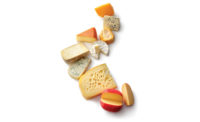
John A. Lucey is a professor of food science at the University of Wisconsin, Madison, and the director of the Center for Dairy Research.
Fresh, squeaky cheese curds are a popular and delicious snack here in my home state of Wisconsin. National sales numbers for natural cheese curds have steadily increased to around $52 million in 2021. However, fresh cheese curds are still predominantly purchased in the Midwest. We are fortunate in Wisconsin that we have many local cheese plants and therefore access to fresh cheese curds. This isn’t the case in most parts of the U.S. Here at the Center for Dairy Research (CDR), we are beginning research to hopefully increase the accessibility of squeaky cheese curds to consumers across the U.S.
Ideally, for best flavor and maximum squeak, fresh cheese curds are consumed the day they are made. Plain, fresh cheese curds don’t have a lot of flavor. They have a salty taste because the curds have just been salted. They also have some acidity and fresh milky flavors or notes. Of course, its unique feature is its squeakiness. When chewing fresh cheese curds, the cheese produces a squeaky noise and sensation in the mouth. Some level of squeakiness can last up to 10 days after manufacture, depending on the cheese.
Why do fresh cheese curds lose their squeak? It’s believed that the loss of squeak is mostly due to calcium-protein changes — although proteolysis or protein breakdown may also be involved. In young cheese curds, the protein matrix is still bound tightly together and is springy. As the cheese gets older, there is more time for the redistribution of free moisture, partial demineralization, or proteolysis to occur. Each of these changes can contribute in different ways to textural changes, most notably, softening of the cheese. This softening is a normal part of cheese maturation but may be detrimental to the ability of the cheese to squeak.
At CDR, we are trying to put some science behind the squeakiness of cheese curds. We are beginning a research project that will be using a texture analyzer to measure the force needed to cut/break curds and, simultaneously, measure and quantify the sound or squeak. We will look at how these properties change with age giving us clues as to the causes for the loss of squeakiness.
However, this project may not be that straightforward. It is believed that some of the sound occurs in the mouth due to the interactions between our teeth, saliva, and the cheese. One theory is that the squeakiness of fresh cheese curds is caused by the “stick-slip phenomenon.” This occurs when your teeth compress the curd; the tightly interconnected protein structure of the curd is strong enough to resist breaking (stick phase). Then, when your teeth provide enough force/deformation, the matrix will break (slip phase), thereby releasing the stored-up energy from the stick phase in the form of a squeaky sound as the teeth pass through the curd. Graduate student Maggie Becher is collaborating with campus experts to devise a method to record and quantify the complex sound behavior as people chew cheese curds.
Through our research, we’d like to better understand what processing methods, ingredients, or strategies might result in cheese curds with a longer shelf life (and squeak). Perhaps we can explore using rennets that are less proteolytic to see if that’s an important factor. Another strategy is freezing. Preliminary trials indicate that freezing cheese curds while they are still fresh may be a strategy to extend the squeak. Another method to extend squeak is to microwave the cheese. As mentioned, the squeakiness of fresh cheese curds is at its highest when the curds are within the first few days after manufacturing, but we’ve found that cheese curds that are up to two weeks old can regain their squeak when warmed up in the microwave.
Fresh, squeaky cheese curds are a lot of fun to eat. We want more people all across the U.S. to experience fresh, squeaky cheese curds, which will require researchers developing ways to extend the shelf-life for this enjoyable dairy product.




